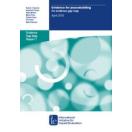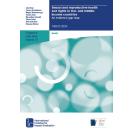
Evidence for peacebuilding: an evidence gap map
3ie Evidence Gap Map Report 1
Around 70 per cent of fragile states have seen conflict since 1989 and 30 per cent of official development assistance is spent in fragile and conflict-affected situations. The challenge is to make evidence-informed investments so that peacebuilding interventions can achieve positive impacts, even in situations where development indicators are worsening.
This report by Drew B Cameron, Annette N Brown, Anjini Mishra, Mario Picon, Hisham Esper, Flor Calvo and Katia Peterson is based on a 3ie evidence gap map (EGM) for the impact evaluation of peacebuilding interventions developed in 2015. It describes the scope and methods for the EGM and the analysis of the information in the map. The EGM reveals two intervention categories, community-driven reconstruction and psycho-social programmes for victims, with a large number of studies that are thus promising for evidence synthesis research. There is little to no evidence available for most of the other 23 categories, while five categories have no completed or ongoing studies.
While we have updated the map since, an offline, excel version is still available for download.
Our new map includes recent studies and highlights gaps that persist. Use the links below to access the latest evidence:




